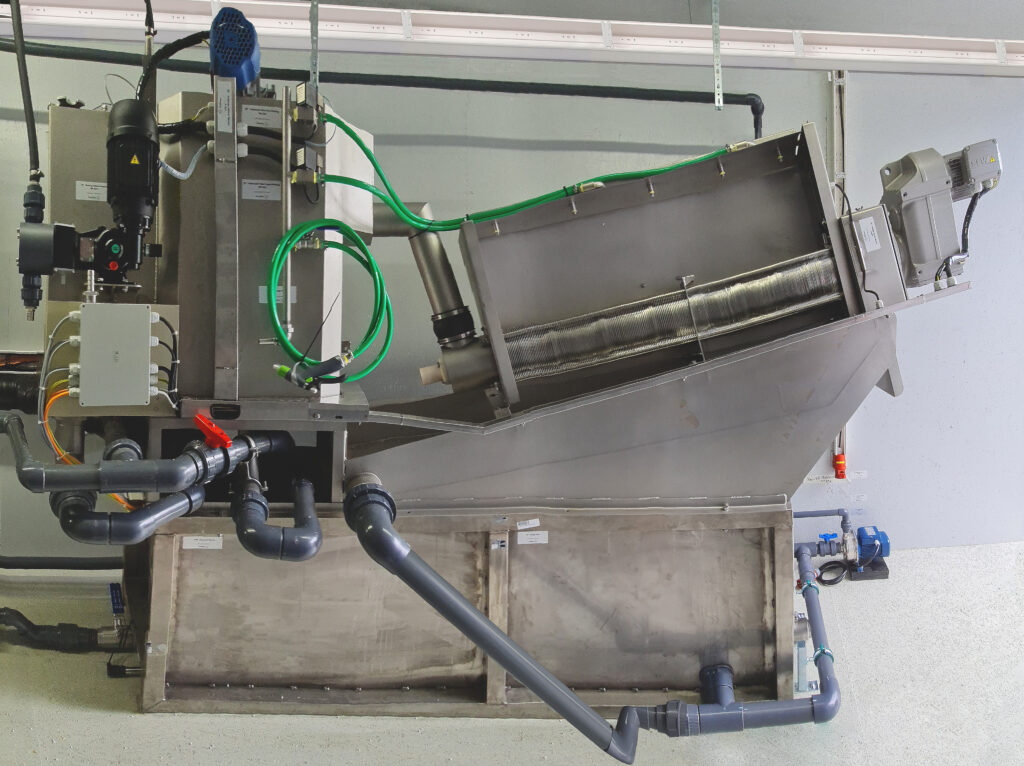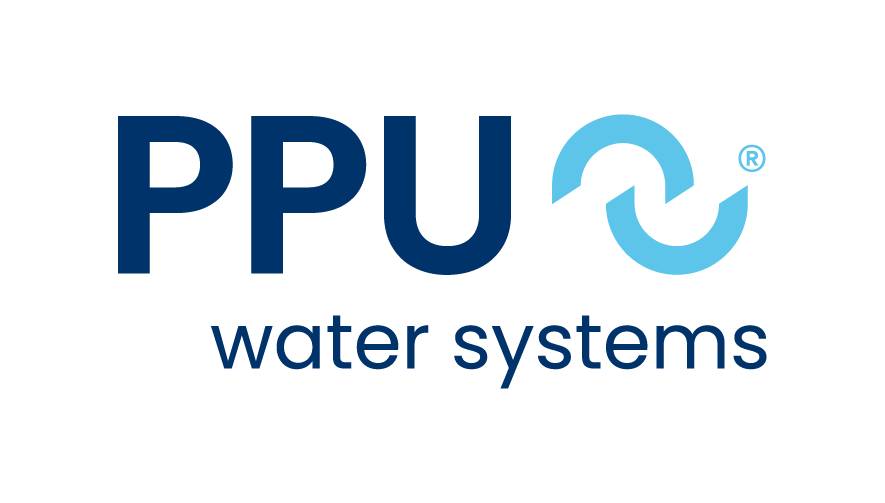ClearFox® Screw Press
Dewatering System
Sludge Handling and Reduction
- Self Cleaning
- No Clogging
- Low Operational Costs
- Flexible Deisgn
Gallery
Description
The ClearFox® Screw Press is a mechanical dewatering machine used in industrial and municipal wastewater treatment to reduce sludge volume. Its versatility allows for efficient dewatering of various sludge types, including biological and flotation sludge. During the process, sludge is continuously thickened and dewatered, resulting in significant cost savings due to reduced disposal volumes. The ClearFox® Screw Press can handle up to 420 kg of dry solids per hour.
How It Works
- The sludge is pumped into the inlet chamber of the screw press. There, the inflow is evenly distributed. In the mixing chamber, a flocculant (polymer) is then added to bind fine suspended solids into larger flocs.(1)
- The pre-thickened sludge-floc mixture then flows into the pressing section. A screw conveyor with variable pitch transports the sludge through a screening system consisting of fixed and moving stainless steel plates. The fixed plates form a static grid structure, while the moving plates ensure continuous self-cleaning during operation.(2)
- At the end of the screw, a spring-loaded pressure plate creates backpressure, further compressing the sludge and increasing the dewatering efficiency. The separated water is returned to the buffer tank (pump sump) of the system. The dewatered sludge is discharged in compact form into a collection container. (3)


The system operates fully automatically, and all relevant parameters can be adjusted via a control display. Optional remote monitoring with remote access allows real-time status checks and convenient adjustments from a distance. The standard scope of supply for the ClearFox® screw press includes:
• screw press with integrated sludge tank
• flocculation reactor with agitator and polymer tank
• collection container for the dewatered sludge
Advantages
- Cost Savings
High dewatering performance reduces disposal costs
Our ClearFox® screw press achieves dry solids contents of up to 30 percent, and even higher depending on the type of sludge. The significant volume reduction leads to less sludge requiring disposal. As a result, operators benefit from noticeably lower disposal costs.
- No Clogging
Maximum operational reliability
The screw press is built for long-term, trouble-free operation. It can be continuously loaded and, thanks to the annular space principle, operates completely without clogging.
- Low Operational Costs
Minimal operating costs
With its high energy efficiency and low personnel requirements, the screw press offers especially economical operation. Low power consumption, easy handling and minimal maintenance effort result in consistently low operating costs.
- Flexible Design
Individually adaptable to your application
The ClearFox® screw press can be tailored to different sludge types and application areas. The dry solids content can be precisely adjusted, as can the material version of the unit. Depending on the requirement, stainless steel, duplex, super duplex or epoxy-coated options are available. We will be happy to advise you and help select the best configuration for your specific application.
Videos
Specifications
| ½ Lamella clarifier module | |
|---|---|
| Dimensions: (l, w, h) / ½ module (m) | 1,35 x 2,10 x 2,57 |
| Footprint: (m²) | 2,8 |
| max. transport weight: (kg) | 400 empty |
| Max. operating weight: (kg) | 8000 filled with water |
| Max. Flow rate | 9 m³/hr |
Downloads
Reference Projects
FAQs
1. What is a sludge screw press and how does it work?
A sludge screw press is a mechanical dewatering system for reducing the water content in sewage sludge. It works with a rotating screw shaft inside a perforated cylinder through which the sludge is continuously transported and increasingly compacted. The ClearFox® variant utilises three zones: Thickening, filtration and compression to achieve a high dry matter content (up to 30-40%).
2. Which sludge types is the sludge screw press suitable for?
The press is versatile and can be used for
- DAF sludges (3-5 % dry matter)
- Secondary sludge from biological treatment (1 % dry matter)
- Mixed sludge (e.g. from FBBR or SBR systems)
- Digestate and industrial process sludge
3. How is clogging prevented?
The press utilises a self-cleaning ring chamber principle: moving and fixed rings ensure continuous cleaning of the filter area and prevent deposits, even during continuous operation.
4. What role does polymer dosing play in dewatering?
Polymers improve the flocculation of solids and increase dewatering efficiency. Dosing is recommended for biological sludge (e.g. secondary sludge). The ClearFox® press offers an integrated flocculation system with mixing line and tank.
5. What capacities are covered by the different press models?
Depending on the model, the processing capacity is between:
- DAF sludge: 0.4-1.6 m³/hr (corresponds to 50-267 kg/hr dry matter)
- FBBR/SBR sludge: 2.0-8.0 m³/hr (corresponds to 40-213 kg/hr dry matter)
6. What feed concentrations can be processed?
The press processes sludge with 0.2 % to 5 % dry matter. Feed concentrations of 2-50 g/l are possible without any problems.
7. How compact is the system?
The screw presses are extremely space-saving. Even the largest standard press requires less than 2.6 metres in length and just under 1 metre in width. Ideal for retrofitting in existing systems.
8. How complex is the installation on site?
Thanks to the plug & play design, installation is minimally invasive. The press is supplied pre-assembled, including storage tank, flocculation module and discharge unit.
9. Can the press run continuously?
Yes, the ClearFox® sludge screw presses are designed for continuous 24/7 operation.
10. How maintenance-intensive is the screw press?
The design is low-wear. Thanks to self-cleaning rings and the absence of sensitive diaphragms, maintenance is reduced to visual inspections, lubrication and occasional cleaning of the reservoir.
11. Can the press be operated mobile?
Yes, it is ideal for mobile systems or temporary use, e.g. on construction sites, for system conversions or in disaster control.
12. Why is the screw press a better alternative to belt or chamber filter presses?
- No high water pressure or air requirement
- Less space required
- Significantly lower maintenance costs
- Fully automated continuous operation possible
- Less operating personnel required
13. What savings are possible through dewatering?
Depending on the initial water content and dry substance, the volume and thus disposal costs can be reduced by up to 80 %.













